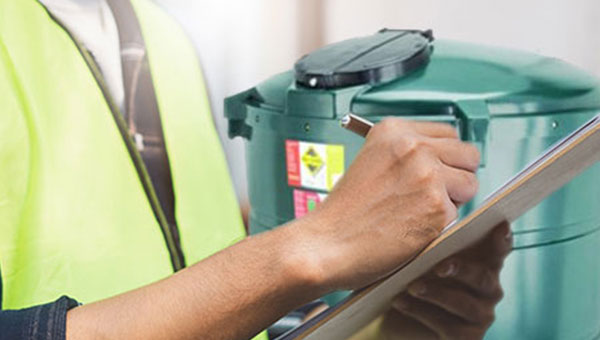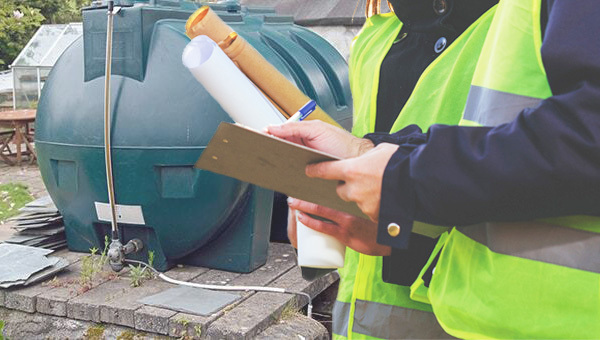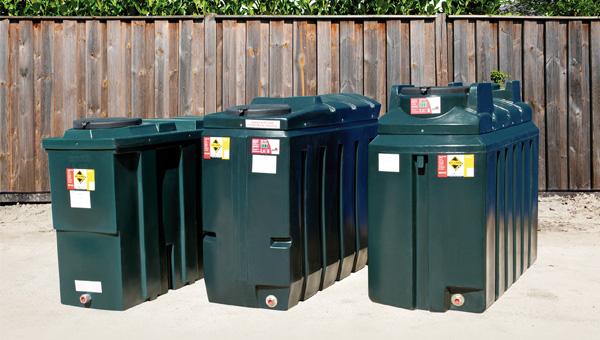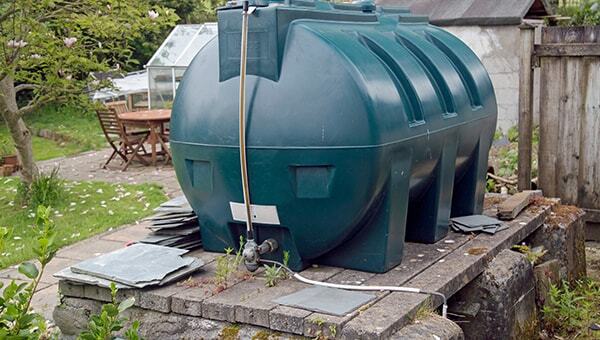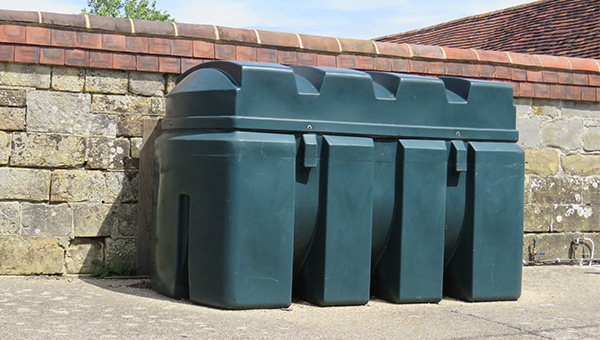
Over a million homes in the UK are not connected to the national gas grid. Whether by choice or necessity, these properties have to rely on off-mains solutions to fuel their heating systems. Currently, heating oil is still one of the best alternatives to gas in the UK, but it has to be delivered by road to, and safely stored on, your property in order for you to use it.
Storing oil for domestic, commercial or agricultural use can have numerous benefits. Key amongst these is the fact that having your own supply of oil means you can be less reliant upon, or completely free from, the national supply. This gives you greater control over the cost of your heating fuel, allowing you to take advantage of price fluctuations and buy in bulk. However, before you can do that, you need to have something to store the oil in…you need an oil storage tank.
Oil tanks are off-mains fuel storage solutions that come in a variety of shapes and sizes to suit all needs. But what do you need to know about them? What are the risks and restrictions that caveat this ideal solution? These are the questions we shall try to answer for you in this article.
Introduction to heating oil
Before we start taking a detailed look at the ins and outs of the tanks used to store heating oil, it’s worth having a quick look at what heating oil is and the advantages and disadvantages of having a property that runs on it.
What is heating oil?
For domestic applications, heating oil is a fuel source used to power a boiler that supplies hot water and central heating to a property. For commercial applications, such as construction and agriculture, heating oil can also be used to fuel machinery and furnaces, generate electricity, and produce steam.
What types of heating oil are available?
There are two types of oil used for domestic heating; kerosene heating oil and gas heating oil. Kerosene is the most common type used in homes these days since it is lighter, cleaner and more efficient, with gas heating oil being used more for commercial and agricultural applications. However, it is worth noting that some older boilers may still require gas heating oil, so do make sure you clarify the type of oil needed if you plan to buy a property that has an oil-fired heating system. If at all unsure, always consult a registered OFTEC technician.
Note:OFTEC (Oil Firing Technical Association) is a trade association in the UK and Ireland that designates and recognises technicians who are qualified and approved to install and maintain oil, solid fuel, and renewable heating systems.
What are the advantages and disadvantages of heating oil?
Buying a property that isn’t connected to the gas mains can be a big decision. It certainly comes with a lot more responsibility than a house connected to the national grid, but there are also some clear advantages that are worth noting.
Advantages of using heating oil:
- Burns hotter than gas - heating oil can warm your house quicker than both gas and electric powered heaters.
- Cheapest alternative to gas - per kWh, heating oil is cheaper than electricity and, depending on the time of year, can be almost as cheap as gas.
- Can be more efficient than gas - modern heating oil systems can exceed 90% efficiency, meaning that more fuel is converted into heat than with older gas and electric systems.
- Gives you more control over your supply - buying your supply in bulk allows you to shop around for the best deals.
However, as with most things in life, there are also a number of disadvantages, risks and restrictions that have to be considered.
Disadvantages of using heating oil:
- Non-renewable - heating oil is a fossil fuel, meaning that is one of the less environmentally friendly ways to heat your home.
- Requires road delivery - your supply of heating oil can be impacted by bad weather due to it having to be delivered in a tanker.
- Fluctuating prices - modern heating oil systems can exceed 90% efficiency, meaning that more fuel is converted into heat than with older gas and electric systems.
- Environmental responsibility - oil leaks can be devastating to the environment, therefore the storage of it is highly regulated and comes with personal responsibility for the homeowner.
This last point is probably the most important issue to consider. Whether you are buying a house with an existing oil tank or plan to install a new one, you must make sure you understand the requirements and responsibilities that surround the installation of oil storage tanks.
What are the regulations for oil storage?
Generally speaking, the regulations for storing heating oil on your property are primarily concerned with fire safety and minimising environmental risk. There are very specific rules for where you can and cannot locate an oil storage tank on your property and what type of protections must be put in place.
Is storing heating oil a fire risk?
If stored correctly in a suitable tank, your heating oil is highly unlikely to just spontaneously combust one day. The concern is more to do with fires that start elsewhere. Even a small storage tank holds enough oil when full to pose a potential hazard if exposed to fire. That is why it is still important to comply with the fire separation distances, and install fire protection barriers if necessary, to minimise the risk of your oil tank being exposed to fire.
What are the environmental risks of storing oil?
Pollution caused by spillages is the main concern. If your tank is installed or maintained incorrectly, it could lead to oil leaks that can cause significant damage to the environment, especially if there are waterways nearby. As the property owner, YOU are responsible for the clean up of any leaks and can be held liable for any damage caused to the environment. Adhering to the regulations and maintaining your tank well is the best way to limit this risk.
Are there any installation restrictions for oil tanks?
All oil storage tank installations must comply with regional building regulations. OFTEC registered technicians can self-certify their own work without involving Local Authority Building Control in England & Wales. However, if you choose a technician who isn’t registered with a scheme like OFTEC, you will then be required to arrange for an inspection from your local building control authority, which can be costly and time-consuming. Similar rules apply in Scotland, where you may need to apply for a warrant before installing your tank.
It is also crucially important to provide a suitable base for your tank to sit on. If the tank is not adequately supported, its structure can be weakened, which may eventually compromise its ability to keep its contents secure.
How do you protect your tank against oil theft?
Oil thefts have been on the rise in recent years due to exceptionally harsh winters and higher fuel prices. Therefore, protection against it should be considered when planning the placement of your tank. The main things to consider are as follows:
- Is the tank easily visible from your property?
- Can it be secured in a lockable compound?
- Could you install an alarm to alert you to sudden oil level drops?
Making your tank less visible, restricting ease of access, and installing alarms can all help to prevent oil theft. However, it is important to remember that any preventative measures put in place MUST still comply with the installation and fire safety regulations for oil storage tanks.
Assuming you are confident that you can comply with all of the above, and are happy to take on the responsibility of storing heating oil on your property, it’s time to take a look at the types of oil tanks available.
What type of oil tank do you need?
Choosing the right oil tank can be tricky, given how many different options there are, but this can be made easier by first understanding the needs of your property and any potential restrictions. Before you start comparing oil storage tanks online, ask yourself the following questions:
How much space do you have for an oil tank?
Initially, you might be thinking that bigger is better when it comes to oil tanks. The bigger the tank, the more oil you can fit in it. The more oil you have stored, the longer it will last. The more oil you can order in one go, the cheaper it will be in the long run if you shop around for the best deals. Makes sense, right?
Well, yes…but only if you have plenty of compliant space on your property. Taking into account all of the regulations mentioned earlier, you might find that you are somewhat limited on the size of oil storage tank you can safely install. If space is an issue, you need to work out what the maximum sized tank you could accommodate is, as this may influence the style of tank you need.
Will your oil tank be indoors or outdoors?
Just to be extra clear before going any further…please NEVER store any fuel inside your house! When we talk about storing an oil tank indoors, we mean in a garage, shed, or other outhouse structure.
Keeping your tank outside is the easiest option when it comes to compliance with the regulations, as it gives you more space to work with. However, it does come with an increased risk of damage from the elements and theft by unscrupulous ne’er-do-wells. You need to ensure that the location minimises the risk of damage, adheres to the minimum fire safety distances, and is nowhere near any water sources. Do make sure you check out our guide to oil tank regulations for more on this.
The installation of your tank is also subject to building regulations, which require it to sit on a solid (concrete or stone slab), level base, suitable for supporting the full weight of the tank, that extends at least 300mm beyond the widest part of the tank in all directions. If your tank is not adequately supported, it can compromise the structural integrity and lead to oil leaks.
If you do plan to keep your tank secured in an outbuilding, to try and avoid some of these issues, just remember that its positioning still needs to follow the regulations.
How much heating oil will your property need?
This is a tricky one. The answer depends on a number of factors. However, as a VERY rough guide, we’ve put together the following table to give you an idea of what you might require.
| Suggested oil storage tank volumes based on average house sizes | |||
|---|---|---|---|
| Boiler Size | No.of Bedrooms | No.of Radiators | Suggested Tank Size |
| up to 15kW | 2-3 | up to 8 | 1000-1300L |
| 15kW to 25kW | 3-4 | up to 10 | 1800L |
| 25kW to 36kW | 4-5 | up to 15 | 2000-2500L |
| 36kW to 45kW | 4-5 | up t0 20 | 3500L |
The amount of heating oil your property will use will depend on its size, how many radiators it has, whether the oil supply is also being used for any appliances (such as an AGA cooker), and what type of boiler you have (a combi boiler will use more oil than a heat only boiler). For example, a 32kW combi boiler can run up to 15 radiators, but a 30kW heat-only boiler can run up to 20, meaning the suggested 2500L oil tank above may not be big enough for that system.
This is why it is important to fully understand your needs before buying your tank. The instructions that came with your oil-fired boiler should be your first port of call, but if you can’t find the information you need, always speak to a professional. Undersizing your oil tank can be a costly error that you definitely want to avoid.
If we say the average 3-4 bed house uses around 18,000kWh for its heating system, and you get roughly 10kWh from 1 litre of (kerosene) heating oil, that would mean the yearly oil consumption for the property would be around 1,800 litres. If that property had space for a 2000L oil storage tank, it would potentially get away with just one refill per year. If it only had space for a 1000L tank, though, it would probably need refilling 2-3 times a year. Keep in mind that, to help avoid spillages, you should only ever have your tank filled to around 80-90% of its capacity, maximum. It is also advisable to never let the level of oil in the tank drop to less than a quarter full without ordering more. Proper planning can help you save money (if you fill your tank in the summer months when oil is cheaper) and avoid the possibility of being left without heating in the winter months.
- Material Type
- Tank Structure
Oil storage tanks are made from either polyethylene plastic or steel. Each have their own advantages and disadvantages, but both make good quality tanks. Steel tanks are typically more durable and can be made to accommodate much larger capacities, but they are more expensive and can be prone to rust. Plastic tanks are typically lighter, more manoeuvrable, cheaper, and often have a seamless design, making them less likely to split. Plastic tanks tend to be more suitable for domestic use (up to 3500L), whereas steel tanks are likely to offer more commercial benefits.
Both plastic and steel oil storage tanks come in either single-skin or bunded options. Single skinned tanks only offer one layer of material between the oil within and the outside world. Bunded tanks are essentially a tank within a tank, offering an inner layer that holds the oil and an outer layer that offers extra protection from leaks and spills. Oil tanks made with a single skin are the cheapest to buy and can be effective solutions in certain situations, but there are extra regulations governing their use due to them being a higher pollution risk. Tanks that are double layered (bunded) cost more, due to the extra material used in making them, but are substantially more reliable and significantly reduce the environmental risks of storing oil on your property.
For a more detailed look at the pros and cons of each tank type, check out our dedicated article “Single Skin or Bunded - which type of oil tank is best?”.
Whichever style of oil storage tank you do go for, always make sure that it meets the relevant manufacturing and quality standards. As a minimum, all oil storage tank manufacturing must comply with BS EN ISO 9001, the tanks must be made from a sufficient material that won’t leak or burst from ordinary use, and have a 20 year minimum life expectancy with proper maintenance. Oil tanks are not cheap products, so you don’t want to be left having to replace them more often than absolutely necessary. Depending on the material your tank is made from, there are two additional standards you need to look for.
- Plastic oil storage tanks - must comply with BS EN 13341 standards and be CE marked for heath, safety, and environmental protection reasons. They should also ideally be manufactured to OFTEC Standards OFS T100.
- Steel oil storage tanks - must comply with BS 799 standards and should also ideally be manufactured to OFTEC Standards OFS T200.
If this information isn’t clearly visible in the product descriptions, make sure you double-check with the supplier or manufacturer.
Note:Do not confuse the life expectancy of your oil tank with any guarantee a supplier or manufacturer offers. Guarantees offer financial protection against manufacturing defects, they are not an indication of how long they should last before needing to be replaced. If a manufacturer guarantees their product for 10 years, subject to proper installation and usage conditions, the tank itself should last a lot longer than that if properly maintained.
Installation and maintenance of oil storage tanks
Once you have chosen the most suitable tank for your property, the next step is to get it installed. For this we would highly recommend calling in an OFTEC approved professional, especially if you are also installing a new oil-fired boiler too. The ramifications of having a poorly installed oil heating system are too costly to take a chance on. An oil leak can end up costing you thousands of pounds in clean up fees and liability fines.
If your oil tank isn’t installed by someone registered with a suitable “Competent Person” scheme, you would need to get a Building Control Notice from your local council and pay for an inspection. Without this you will not receive the compliance certificate needed for selling your property, should you ever decide to do so. Having your oil tank installed by a registered professional saves any of this hassle. If installed correctly, your oil tank should serve you well for many, many years without requiring too much of your attention. Obviously, you do need to keep an eye on your oil levels to ensure you don’t run out, but most manufacturers offer monitoring and alarm devices to help with this.
And that’s our basic guide to oil storage tanks. If, after reading up on all the information available, you decide it's time to take a closer look at your tank options, our "what type of oil tank do you need" article might be able to help. Should you already feel that high-quality polyethylene oil tanks are the way to go, we stock a great range of single skin and bunded tanks over in our Oil Storage Tanks section that we’d recommend taking a look at.
Should you have any questions or need any further advice about oil storage options, though, contact JDP today. Our team of experts are always on hand to help with all of your civils and drainage needs.



